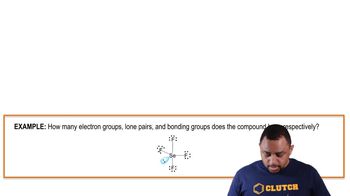Determine the molecular geometry and sketch each molecule or ion using the bond conventions shown in 'Representing Molecular Geometries on Paper' in Section 10.4. c. IF2-
Ch.10 - Chemical Bonding II: Molecular Shapes & Valence Bond Theory

All textbooks Tro 4th Edition
Tro 4th Edition Ch.10 - Chemical Bonding II: Molecular Shapes & Valence Bond Theory
Ch.10 - Chemical Bonding II: Molecular Shapes & Valence Bond Theory Problem 40b
Problem 40b
 Tro 4th Edition
Tro 4th Edition Ch.10 - Chemical Bonding II: Molecular Shapes & Valence Bond Theory
Ch.10 - Chemical Bonding II: Molecular Shapes & Valence Bond Theory Problem 40b
Problem 40bChapter 10, Problem 40b
Determine the molecular geometry and sketch each molecule or ion, using the bond conventions shown in 'Representing Molecular Geometries on Paper' in Section 10.4. b. SCl6
 Verified step by step guidance
Verified step by step guidance1
Determine the central atom: In SCl_6, sulfur (S) is the central atom because it is less electronegative than chlorine (Cl) and can form multiple bonds.
Count the total number of valence electrons: Sulfur has 6 valence electrons, and each chlorine has 7 valence electrons. Therefore, the total number of valence electrons is 6 + (6 * 7) = 48.
Apply the VSEPR theory: The molecule SCl_6 has 6 bonding pairs and no lone pairs around the central sulfur atom. According to VSEPR theory, this results in an octahedral molecular geometry.
Sketch the molecule: In an octahedral geometry, the central atom is surrounded by six atoms at 90-degree angles. Use solid lines for bonds in the plane of the paper, wedges for bonds coming out of the plane, and dashed lines for bonds going into the plane.
Verify the geometry: Ensure that the sketch reflects the octahedral shape, with all Cl atoms equidistant from the central S atom, confirming the molecular geometry.

Verified video answer for a similar problem:
This video solution was recommended by our tutors as helpful for the problem above.
Video duration:
1mWas this helpful?
Key Concepts
Here are the essential concepts you must grasp in order to answer the question correctly.
Molecular Geometry
Molecular geometry refers to the three-dimensional arrangement of atoms within a molecule. It is determined by the number of bonding pairs and lone pairs of electrons around the central atom, which influences the shape of the molecule. Common geometries include linear, trigonal planar, tetrahedral, and octahedral, each corresponding to specific arrangements of electron pairs.
Recommended video:
Guided course

Molecular Geometry with Two Electron Groups
VSEPR Theory
Valence Shell Electron Pair Repulsion (VSEPR) theory is a model used to predict the geometry of molecules based on the repulsion between electron pairs in the valence shell of the central atom. According to VSEPR, electron pairs will arrange themselves to minimize repulsion, leading to specific molecular shapes. This theory is essential for determining the geometry of complex molecules like SCl6.
Recommended video:
Guided course

Molecular Shapes and VSEPR
Bonding and Lone Pairs
In molecular structures, bonding pairs are the pairs of electrons shared between atoms, while lone pairs are the pairs of valence electrons that are not involved in bonding. The presence of lone pairs can significantly affect the molecular geometry by altering bond angles and overall shape. Understanding the distribution of these pairs is crucial for accurately sketching molecular structures.
Recommended video:
Guided course

Electron Groups, Lone Pairs, and Bonding Groups Example
Related Practice
Textbook Question
Textbook Question
Determine the molecular geometry and sketch each molecule or ion using the bond conventions shown in 'Representing Molecular Geometries on Paper' in Section 10.4. d. IBr4-
Textbook Question
Determine the molecular geometry and sketch each molecule or ion, using the bond conventions shown in 'Representing Molecular Geometries on Paper' in Section 10.4. c. PF5
1
views
Textbook Question
Determine the molecular geometry and sketch each molecule or ion, using the bond conventions shown in 'Representing Molecular Geometries on Paper' in Section 10.4. d. IF4+
Textbook Question
Determine the molecular geometry about each interior atom and draw each molecule. (Skeletal structure is indicated in parentheses.)
a. C2H2 (skeletal structure HCCH)
b. C2H4 (skeletal structure H2CCH2)
c. C2H6 (skeletal structure H3CCH3)